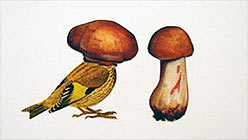As a child, I often watched my mother grind pigments as she prepared to paint. She mixed them in tiny white porcelain cups, and set her papers and brushes out on the kitchen table. She painted a wide variety of subjects, but favored plants, flowers, and other botanical subjects.
Because my mother loved to paint flowers, I continue to associate the phrase “botanical illustration” with women’s work. I can’t help but think of Victorian lady naturalists, painting away in their mutton-chop sleeves. Fragile, yet precise, these Victorian paintings of flowers and leaves exude a strange intensity. Flowers seem an odd, yet appropriate, way to sublimate sexuality.
Last Wednesday, I walked down Market Street to Rare Device to see a small suite of watercolors and collages by the Boston artist Amy Ross. Ross’s paintings have all the strange, fragile intensity of Victorian botanical illustration. Botanical subjects are often surreal all on their own, plants exhibiting a bizarre and disturbing similarity to flesh. Just think of an aloe’s succulent leaves. Certain orchids are almost obscene. Ross takes that resemblance in a different direction.
In her statement, Ross writes, “My drawings offer visual hypotheses to the question: what would happen if the DNA sequence of a plant or mushroom were spliced with that of an animal?”
At Rare Device, we find rabbits twisting out of flower buds, woodpecker heads collaged to mushroom bodies, and in my favorite plant-animal hybrid painting, a pure white magnolia bud contorts, and becomes a floppy-eared goat.


